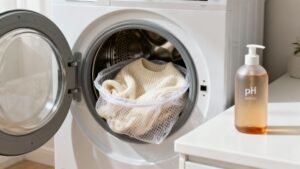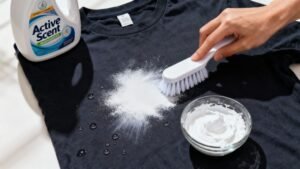
Remove Red Wine Stain From Any Fabric
That gut-wrenching moment a glass of red wine tips over is a classic for a reason. But a splash of Merlot on your favorite white shirt doesn't have to be a catastrophe. The secret to winning the battle against a red wine stain is speed—you have to get to it before the pigments and tannins decide to make your fabric their new home.
With the right moves and a bit of patience, you can tackle anything from a fresh spill on crisp linen to an older spot you just discovered on the carpet.
Immediate Actions for Red Wine Spills
When wine hits fabric, the clock starts ticking. Don't panic and definitely don't scrub—that just grinds the stain deeper. Instead, follow these first-response steps to contain the damage and set yourself up for a successful removal.
| Action | Why It Works | What to Avoid |
|---|---|---|
| Blot, Don't Rub | Gently pressing with a clean, dry cloth lifts the excess wine out of the fibers without spreading it. | Aggressive rubbing or scrubbing, which permanently embeds the stain. |
| Apply Salt or Baking Soda | These absorbents act like a sponge, drawing the wine up and away from the fabric. | Leaving the stain to air-dry. This allows the tannins to set. |
| Rinse with Cold Water | Flushing from the back of the stain pushes the pigments out, rather than through the fabric. | Using hot water, which can "cook" the stain and make it permanent. |
These initial actions are your best defense against a permanent mark. Once you've pre-treated the area, you're ready for the main wash.
Why Red Wine Stains Are So Notorious
So, what makes a Cabernet spill so much more menacing than, say, white wine? It’s all down to the chemistry of the grape. Red wine is loaded with natural compounds that are practically designed to leave a lasting impression.
To truly master how to remove stains from shirts, it helps to know your enemy.
The Science of the Spill
Two key components in red wine are responsible for its staining power:
- Chromogens: These are the pigment-producing compounds that give red wine its beautiful, deep color. Think of them as natural dyes just waiting to latch onto a clean, light-colored surface.
- Tannins: These are plant-based polyphenols, the very same compounds used in inks and dyes. Their entire purpose is to bind to things—which is great for winemaking but terrible for your tablecloth.
It's a huge issue, too. The global market for stain remover products was valued at USD 23.4 billion for a reason—everyone is searching for a reliable fix.
Once you’ve successfully pre-treated and lifted the stain, the final step is a thorough, restorative wash. This is where a high-performance detergent like Active Scent's odor-free laundry detergent comes in. It has been carefully formulated for a deep and effective clean, without competing fragrances. It's the ultimate neutral base, created to perfectly complement our range of luxury scented fabric softeners. The result is laundry that’s not just clean, but exquisitely scented.
Using Household Staples on Fresh Stains
That heart-stopping moment when a glass of red wine tips over doesn’t have to end in a permanently stained favorite shirt or tablecloth. If you act fast, your kitchen pantry probably has everything you need for the first line of defense. The trick is to get to it before the stain dries and truly sets into the fabric.
The classic salt trick is a go-to for a reason—it works. After blotting up as much of the spill as you can with a clean cloth, pile on the table salt. And I mean pile it on. You want a thick mound completely covering the wine.
You’ll actually see the salt turn pink as it pulls the wine's pigment right out of the fibers. Let it sit for at least 10 minutes, but for a big spill, an hour or two is even better. Once it's done its job, just scrape or vacuum it off and give the spot a rinse with cold water.
Creating a Baking Soda Paste
Another fantastic kitchen staple for stain fighting is baking soda. It's a mild abrasive that’s gentle on most fabrics but tough on stains.
Here’s how I like to use it:
- Whip up a paste: Mix about three parts baking soda to one part water. You’re looking for a thick, spreadable consistency, almost like toothpaste.
- Cover the stain: Gently spread the paste over the entire red wine mark.
- Let it work its magic: As the paste dries, it lifts the stain right out of the material. This takes patience—it could be a few hours.
- Clean it up: Once it’s totally dry and crumbly, brush or vacuum off the residue and rinse the area with cool water.
This method is a lifesaver for things you can’t just toss in the wash, like a sofa cushion or a rug. It’s a similar emergency tactic to what we recommend in our guide on how to remove coffee stains from a shirt.
The Club Soda Blotting Technique
Finally, there’s club soda. The carbonation is brilliant for lifting stain particles, but the technique is everything. Whatever you do, don't just pour it on.
Pouring club soda directly on the stain will only make it spread, turning a small spot into a giant, faded mess. Instead, get a clean cloth damp with club soda and blot the stain, working from the outside edges inward. This contains the spill while lifting it.
Think of these household remedies as the essential pre-treatment step. They do the heavy lifting to prepare your fabric for a proper, thorough cleaning that will eliminate any last trace of the stain.
How to Tackle Stubborn Set-In Red Wine Stains
We’ve all been there. The morning after a great dinner party, you discover a dark, dried red wine stain that went unnoticed. It can feel like a lost cause. Once the wine evaporates, its pigments and tannins dig in deep, bonding with the fabric fibers to create a mark that simple blotting won't touch. But don’t give up on that tablecloth just yet. With the right approach, even these older stains can be defeated.
Set-in stains need a different strategy—one that rehydrates and breaks down those stubborn compounds. Red wine is notoriously difficult because of its complex cocktail of tannins, pigments, and alcohol, all designed to last. In fact, wine spills are such a common headache that they've driven huge demand for specialized removers. The latest stain remover market trends show just how universal this problem is.
Using Hydrogen Peroxide and Dish Soap
For whites and other light-colored fabrics, a simple but potent mix of hydrogen peroxide and dish soap can be your secret weapon. The peroxide acts as a gentle oxidizing agent, chemically breaking down the color, while the soap works to lift and carry it away from the fibers.
- Make the paste: Just mix one part dish soap with two parts 3% hydrogen peroxide.
- Apply and wait: Gently work the solution into the stain and let it sit for 20-30 minutes. You should start to see the stain visibly lighten as it works.
- Blot, then rinse: Using a clean, damp cloth, lightly blot the area before rinsing it completely with cold water.
A Crucial Note: Always, always do a spot test on a hidden part of the fabric first, like an inside seam. Hydrogen peroxide has a mild bleaching effect, so this method is not for dark or brightly colored items.
The Power of White Vinegar
If you’re dealing with more delicate or colored fabrics, white vinegar is a gentler but surprisingly effective alternative. The acetic acid is brilliant at neutralizing the deep reddish-purple pigments in the wine.
Just pour a small amount of white vinegar directly onto the stain, making sure it’s fully saturated. Give it about 15 minutes to work its magic and break down the pigments. Afterward, dab a little liquid laundry detergent onto the spot before rinsing everything out with cold water.
Think of these methods as the essential pre-treatment before the final act: the wash cycle. Following up with a truly deep-cleaning detergent like Active Scent's odor-free formula is the key to ensuring every last trace of both the stain and your cleaning solution is gone. This leaves your fabric impeccably clean, creating the perfect canvas for one of our bold, luxurious fabric softeners to truly shine.
Specialized Care for Different Fabric Types
That delicate silk blouse and your sturdy cotton tablecloth have one thing in common: a red wine spill on either is a nightmare. But how you treat them couldn't be more different. The wrong approach can ruin fibers, bleed colors, or set a stain for good.
Getting it right is an art, and it's why the U.S. stain remover market is now worth an estimated USD 5.87 billion. We’re all looking for better ways to care for the fabrics we love.
Not all fabrics are created equal, especially when it comes to a stubborn red wine spill. What saves your cotton napkins might destroy a wool sweater. This quick guide breaks down the safest and most effective methods for common materials.
Stain Removal Guide by Fabric Type
| Fabric Type | Recommended Method | Methods to Avoid |
|---|---|---|
| Cotton & Linen | Blot, then apply a salt paste or a mix of hydrogen peroxide and dish soap. Launder immediately. | Hot water, which can set the tannins in the wine. |
| Silk & Wool | Gentle blotting with cool water and a drop of pH-neutral detergent. Dab, don't rub. | Vigorous scrubbing, harsh chemicals, enzyme cleaners. |
| Synthetics (Polyester, Nylon) | Blot, then use a club soda or a vinegar/water solution. Generally resilient to most treatments. | Bleach on certain synthetics, which can cause yellowing. |
| Upholstery & Carpet | Blot aggressively, use minimal liquid cleaner, and work from the outside in to prevent spreading. | Oversaturating with water or cleaning solutions. |
Knowing the do's and don'ts for your specific fabric is half the battle won. Always test a small, hidden spot first if you're ever unsure.
Delicate Materials vs. Hardy Synthetics
Fabrics like silk and wool require a light touch. Any aggressive scrubbing or harsh chemicals will permanently damage their delicate textures. Stick to gentle blotting with cool water and maybe a whisper of a mild, pH-neutral soap.
Synthetics, on the other hand, can take a bit more of a fight. They are built to be resilient. For a deep dive into materials like polyester, our complete guide on how to clean polyester has you covered. And for tricky items like sheepskin boots, this detailed guide on removing stains from Uggs offers some fantastic, specialized advice.
Tackling Upholstery and Carpets
When wine hits your sofa or rug, the goal is to lift the stain out, not push it in. You need to act fast, but with precision.
- Blot, Blot, Blot: Grab a clean, dry cloth and press firmly to soak up as much of the spill as you can. The more you lift now, the less you have to treat later.
- Go Easy on the Liquid: Apply your cleaning solution with a cloth, not by pouring it on. You want to treat the surface fibers, not the padding underneath.
- Work from the Outside In: To keep the stain from spreading like a bullseye, always start blotting at the edge of the spill and move toward the center.
The biggest mistake I see with upholstery is using too much water. It just pushes the stain deeper and can leave a giant water ring that's worse than the original spot. Always blot, never soak.
Once you’ve pre-treated the stain, the final wash is what truly restores your fabric. Using Active Scent’s odor-free detergent provides a powerful, deep clean that erases any lingering residue. It creates the perfect blank canvas, leaving your fabrics impeccably clean and ready to be enveloped in one of our perfumer-crafted luxury softeners.
The Final Wash for a Flawless Finish
You’ve done the hard work of pre-treating that stubborn red wine stain. Now comes the moment of truth: the final wash. This isn't just about rinsing away the pre-treatment; it’s the critical step that lifts every last trace of pigment and restores your fabric to its original glory. At Active-Scent.com, we believe in powerful detergents fused with luxurious fragrances.
To truly erase the evidence, you need powerful cleaning with zero interference. We specifically designed Active Scent’s odor-free laundry detergent for this exact challenge. It has been carefully formulated for a deep and effective clean, without competing fragrances, ensuring that the only thing left is pure, clean fabric.
This is what separates a stain that’s "mostly gone" from one that has completely vanished. Our detergent creates the ultimate neutral canvas.
Elevate the Everyday Ritual
Once your garment is impeccably clean, it’s ready for the final touch—an unforgettable fragrance experience. Inspired by the spirit of iconic French houses like Dior, Mugler, Chanel, and Le Labo, our fragrances are bold, mysterious, hypnotic, and unforgettable olfactory statements. Our perfumer-crafted softeners deliver a spark of joy, a touch of boldness, and a surge of confidence, all wrapped up in a powerful and EXCEPTIONAL product.
Imagine deep, earthy patchouli fusing with the burning radiance of amber, or fiery pimento berries igniting the senses with spice and warmth. Our lead perfumer and aroma designer masterfully master light and shadow, using premium, natural, and ethically sourced ingredients to create scents that leave a lasting impression. It’s a process that demands the same care and attention to detail as our guide on how to wash silk garments.
LAUNDRY NEVER SMELLED SO GOOD!
Common Questions About Red Wine Stains
Even with the best techniques, a few lingering questions always seem to surface when you’re staring down a red wine spill. Getting the right answers can be the difference between a pristine rescue and a permanent, frustrating mark. Let's clear up some of the most common myths.
Can I Use Bleach on a Red Wine Stain?
Tempting, but it’s a huge gamble. Using chlorine bleach, even on a white cotton shirt, is a risky move. It can cause permanent yellowing over time and seriously weaken the fabric's fibers. And on colored clothes? It will strip the color right out, creating an even bigger, splotchier problem.
It's far safer to stick with an oxygen-based bleach or a hydrogen peroxide solution—but always do a quick spot test on a hidden area first.
Will a Clothes Dryer Set the Stain Permanently?
Absolutely, 100% yes. Heat is the ultimate enemy of a wine stain. The high temperature from a dryer will essentially bake the wine’s pigments into the fabric, making that mark nearly impossible to remove later on.
Always, always double-check that the stain is completely gone after washing and before you even think about putting it in the dryer. If there’s any doubt, let the item air-dry first. You can always wash it again if you need to.
Does Salt Work on Old, Dried Red Wine Stains?
Salt is a hero for a fresh spill. Its entire purpose is to absorb the liquid wine before it has a chance to soak deep into the fibers.
Once a stain is old and dry, though, salt has nothing to absorb. At that point, its job is done. You’ll need a liquid-based treatment, like a vinegar solution, to rehydrate and start breaking down those stubborn, set-in pigments.
After conquering the stain, the final wash is your victory lap. Our powerful, odor-free Active Scent detergent delivers an exceptional clean without any competing fragrances. It creates the perfect neutral canvas for our luxury scented softeners to truly shine, leaving a refined and distinguished sensory experience.
Ready to transform your laundry into an unforgettable sensory experience? Learn more at https://active-scent.com.










